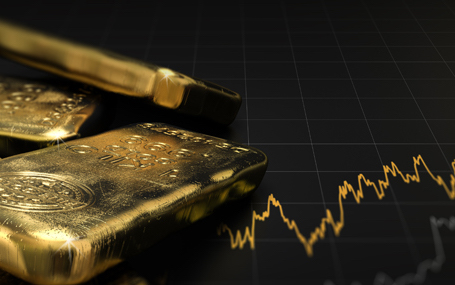by Jurrien Timmer, Director of Global Macro, Fidelity Investments
Are inflation, the Ukraine conflict, and other factors conspiring to push gold higher?
Key takeaways
- Gold is trading within striking distance of its all-time high near $2,000.
- Several factors, such as inflation and the war in Ukraine, appear to be behind gold's recent momentum.
- History suggests gold prices could go higher.
Long-term gold bugs have generally been rewarded by the precious metal. Following the big rally from the mid-2000s to a then all-time high above $1,800 in 2011, gold languished for the better part of 7 years. Then, in November 2018, a new bull market for gold ensued, culminating in the all-time record just below $2,000 in July of 2020. It's been mostly sideways since then with gold currently trading just above $1,900 per troy ounce. But I'm now wondering: Could this be the beginning of a new bull market for gold?
What's happening now with gold
In my view, a strange thing has been going on with gold lately—particularly in relation to Treasury Inflation-Protected Securities (TIPS). TIPS are a bond issued by the US government that protects against inflation by increasing in price as inflation increases. The 10-year TIPS is often used as a proxy for real rates, that is, interest rates adjusted for inflation.
Real rates have become decidedly less negative recently after the Fed telegraphed plans to raise rates more aggressively. Historically, when real rates rise, gold prices have typically fallen (see Gold and real rates chart). Based on this, it's possible that gold could have fallen to the low $1,600s recently. Instead, gold has rallied above $1,900.
Is gold trading on a geopolitical premium, following the tensions between Russia and the Ukraine? Is gold betting on a policy pivot by the Fed to higher short-term interest rates? Are supply and demand factors helping drive prices higher?
Diving into gold's past
Let's look into gold's history to see if it can help illuminate gold's future potential. The chart below shows gold prices and real gold (i.e., gold adjusted for inflation) going back to the 1870s. As you can see, the price of gold was fixed until the 1970s, when the US went off the gold standard.
Gold is viewed by many as a hedge against inflation. Indeed, we can see that the big gains in gold prices during the 1970s were in an era of consumer price inflation. Gold went up more than 20-fold during this time, from $35 per ounce to $852 per ounce. When the 1970s inflation surge reversed course during the 1980s, gold followed suit and went into a long bear market.
I think real rates are the driving force to explain what has been happening over the past few decades. The chart below shows 3 versions of real rates: The 10-year TIPS real rate, the 10-year Consumer Price Index (CPI)-based real rate, and the Atlanta Fed Shadow real fed funds rate (which incorporates the Fed's balance sheet).
As this chart shows, periods of below-zero real rates have consistently corresponded to big gains for gold, and vice versa. Thus, I believe that real rates have consistently been a main driver for gold prices. In the chart below, I show a scatter plot of gold vs. inflation on the left, and gold vs. real rates on the right. While these charts may seem complicated, the simple takeaway is this: Inflation is positively correlated with gold (when inflation has risen, gold typically has too) and real rates are negatively correlated with gold (when real rates have gone up, gold has typically gone down).
Of course, we can't forget about the US dollar (USD), which can be a driver for gold. While some large US dollar swings in the past have produced big moves for gold (i.e., in the opposite direction), gold hasn't always moved in reverse lockstep with the USD. The late 1980s and 2000s come to mind. But the dollar remains something to keep an eye on when it comes to gold prices.
What might all this mean for gold now?
The message that I take away from all of these charts is that gold seems to act like a hedge against a loss of purchasing power—whether that's defined as rising inflation, negative real rates, a falling dollar, or all of the above. Sometimes it's just a weak dollar play, other times it's an inflation hedge. In recent years, I think it has been mostly a play on real rates.
To confirm, I also did a regression (i.e., statistical modeling that helps determine the importance of factors or variables) of the year-over-year changes in these various indicators against the change in gold. I did 3 different regressions: The 1968-2019 period, the 1970's, and 1998-2019. They all showed roughly the same thing, which tells me that all of these indicators have stood the test of time in their relevancy as independent variables. By far, the strongest signal came during the 1970s and 1980s, when all these drivers were forcefully moving in the same direction. Inflation was running hot, the dollar was falling, and real rates were negative—until they all reversed during the 1980s.
It's worth noting that, in recent months, these variables have diverged in their ability to explain gold's price moves. The 1970s model suggests that gold should have been up 57% from a year ago (because the inflation weights are heavier in that version). The real rate model suggests a more modest 4% gain, which is in line with the actual change of 3%.
What does it all mean? With real rates becoming less negative (as defined by the TIPS market), while gold is rallying, something is afoot here. I surmise that it could be due in some part to the unique factors of today, such as the Russia-Ukraine geopolitical premium.
But it could also be that, while the Fed is ramping up plans to tighten monetary policy, gold is already moving the next chess piece on the board. Gold has been rallying as the yield curve (e.g., the relationship between the 2-year US Treasury and the 10-year US Treasury) has been flattening (as shorter-term rates have been rising to shrink the gap with longer-term rates). That could be a tell. It's possible that gold investors are getting out ahead of the Fed.
Gold investors seem to generally be betting that the Fed will have no choice but to tolerate above 2% inflation in order to keep the economy from recession—which could mean real rates rise less than expected or not at all, and that could be good for gold.
About the expert

Jurrien Timmer is the director of global macro in Fidelity's Global Asset Allocation Division, specializing in global macro strategy and active asset allocation. He joined Fidelity in 1995 as a technical research analyst.
Copyright © Fidelity Investments















